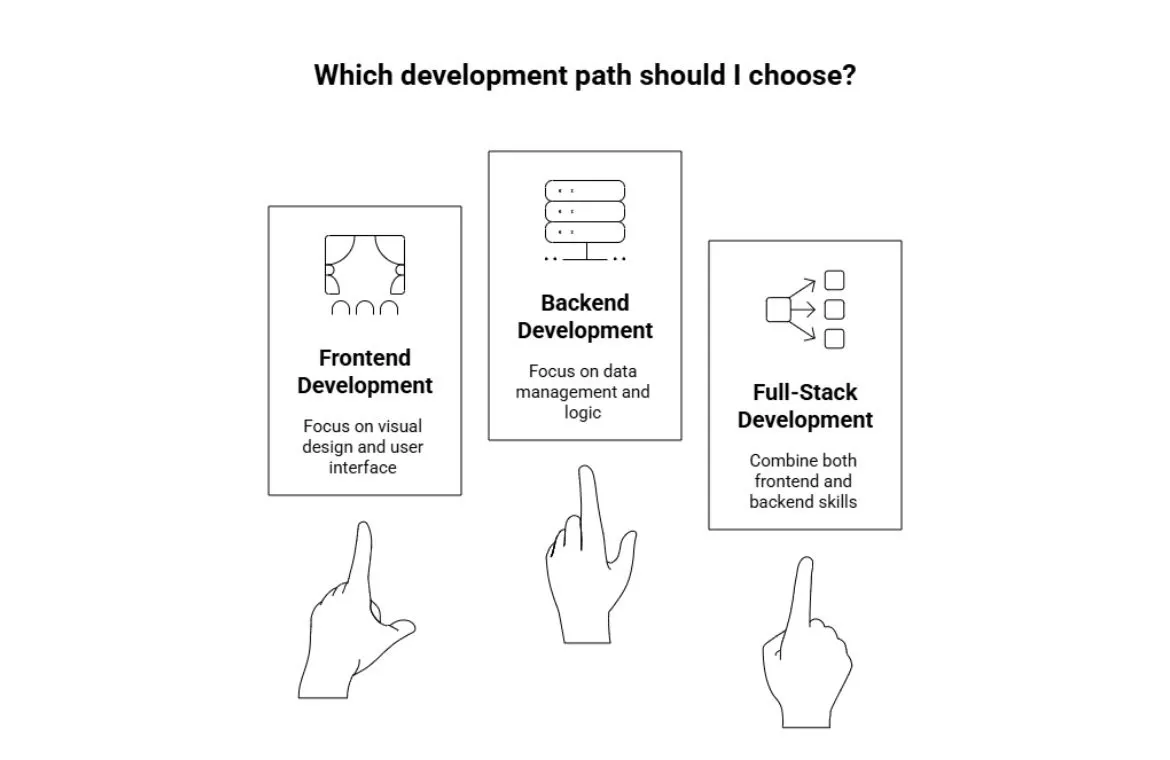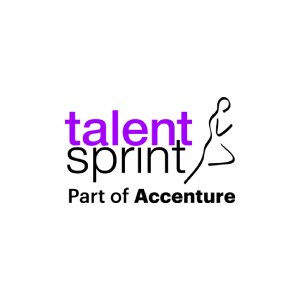Frontend vs Backend- what suits you?

Think of a website like a restaurant. The frontend is what you see the menu, the design, the service. The backend is the kitchen, the recipes, the cooking, and the systems that keep everything working. Both are important, but the skills needed are very different. Which side do you see yourself on?
What is Frontend Development?
“Frontend is the art of making the invisible visible, bringing ideas to life on the screen.”
Frontend development creates the foundation of what users see and interact with on the web. The visual elements and interactive interfaces directly connect with visitors, making it different from backend development.
Frontend development creates the graphical user interface of websites and web applications. Users can view, click on, and interact with everything it includes. A frontend developer's main goal is to craft the user interface that functions smoothly on different devices. The role requires close collaboration with designers and backend developers to deliver uninterrupted user experiences.
Core technologies: HTML, CSS, JavaScript
Three essential languages power frontend development:
- HTML (HyperText Markup Language): Creates the structure and skeleton of web pages, defining elements like headings, paragraphs, and images
- CSS (Cascading Style Sheets): Controls the presentation, styling, and layout of HTML elements, including colours, fonts, and responsive design
- JavaScript: Adds interactivity and dynamic functionality, enabling features like form validation, animations, and immediate updates
These languages complement each other, HTML builds structure, CSS adds style, and JavaScript brings behaviour to web pages.
Common tools and frameworks: React, Angular
Front-end developers use frameworks and libraries to streamline development beyond core languages.
- React, Facebook's powerful JavaScript library, excels at building user interfaces, especially for single-page applications.
- Google manages Angular, which offers a detailed framework for large-scale applications. Built with TypeScript, it provides complete functionality out of the box, making it perfect for well-laid-out projects.
Example: Building a responsive landing page
A responsive landing page showcases frontend skills in action. The process combines HTML for content structure, CSS for visual appeal, and JavaScript for interactivity. Responsive design makes pages look great on devices of all sizes, including desktops, tablets, and phones.
To name just one example, see how landing pages come together. The HTML structure comes first, followed by CSS styling that ensures elements resize properly through media queries and flexible layouts. JavaScript adds features like hamburger menus on mobile or image galleries.
What is Backend Development?
“Backend development is the engine of the web, as users may not be able to see it, but nothing moves without it.”
A sleek website interface sits on top of a resilient foundation of server-side operations that users never see. Web applications rely on backend development. This hidden yet vital aspect powers everything from data storage to business logic.
Definition and server-side responsibilities
Backend development covers the server-side component of web applications and focuses on elements invisible to users. Backend developers build and maintain the technology that processes data and performs operations on servers.
Their work includes database interactions, user authentication, server configuration, and creating application programming interfaces (APIs). They also make sure websites perform correctly by managing expandable systems and optimising web applications for better performance.
Popular languages: Python, Java, PHP
The digital world of backend development features several dominant programming languages with unique advantages:
- Python: This language stands out for readability and simplicity. Python excels in data analysis and artificial intelligence applications. Its extensive standard libraries help developers work faster.
- Java: This object-oriented language follows the "write once, run anywhere" principle. Java suits enterprise applications that need cross-platform compatibility.
- PHP: One of the oldest backend languages still proves remarkably relevant.
Frameworks: Node.js, Django, Express
Backend frameworks make development easier with structured tools and components:
- Node.js: This JavaScript runtime environment lets developers use JavaScript on the server side. It creates a unified language experience across the frontend and backend.
- Django: This Python-based framework follows the Model-View-Controller pattern. Django emphasises quick development with its "batteries-included" philosophy.
- Express.js: A lightweight framework for Node.js that makes API creation and web service development simpler.
Example: Handling user login and database storage
The user login process shows backend code in action. The server verifies submitted credentials against database records. It authenticates users through various steps like token creation, data retrieval, and session establishment. A basic login function matches email and password parameters with database records and returns user information or error messages based on results.
Frontend and Backend Development: The Difference....
Frontend and backend development create two different yet complementary paths in the web development world. These fundamental differences span several key areas.
| Aspect | Frontend Development | Backend Development |
| Core Programming Languages | HTML, CSS, JavaScript | Python, Java, PHP |
| Primary Frameworks/Tools | React, Angular | Node.js, Django, Express |
| Main Responsibilities | - Building user interfaces - Making visually appealing designs - Creating interactive elements - Making apps work across devices | - Managing databases - Setting up servers - Building APIs - Handling user authentication |
| Key Skills Required | - Design approach - Understanding user needs - Creative visualisation | - Problem-solving - Analytical mindset - System design |
| Average Salary (India) (As Freshers) | -3-6 LPA
| - 3-8 LPA
|
1. Programming Languages
Frontend developers work with HTML, CSS, and JavaScript to build user interfaces. Backend developers use server-side languages like Python, Java, PHP, and Ruby. This difference separates client-side development from server-side operations.
2. Frameworks and Libraries
React, a JavaScript library, helps build easy-to-use interfaces with reusable components. It uses a virtual DOM to optimise performance. Django, built with Python, delivers complete backend functionality. It comes with built-in ORM, authentication systems, and security features.
3. Roles and Responsibilities
Frontend developers create appealing interfaces and ensure great user experiences. Backend developers build a reliable architecture that powers application functions quickly and accurately.
4. Skills
Frontend development requires design thinking, which involves understanding user needs to create solutions that connect with users emotionally. Backend development uses traditional problem-solving methods that are more systematic and analytical.
5. Salary
According to Glassdoor, Indian frontend developers earn about 3-6 LPA on average as freshers, whereas Backend developers make slightly more at 3-8 LPA as freshers. This pay difference shows the advanced technical knowledge backend roles require.
The Way Forward: How to choose the Right path?

Still in doubt, on what to choose..??
- Begin with an experiment by building a landing page for a frontend developer and then try connecting it to the database for the backend.
- Reflect upon your actions and ask yourself if you like styling layouts more or making sure that the forms save the data correctly.
- Once you have made up your mind, seek guidance by joining coding forums, LinkedIn groups, or tech meetups to ask professionals about their day-to-day work.
- Then comes the final step of testing the waters, many developers begin with the front end because it’s visual and rewarding, then explore the backend as they get comfortable with logic and data.
In the end, choosing between frontend and backend development is like deciding whether you’d rather design the stage or control the spotlight behind the curtains. Remember, there’s no one-size-fits-all answer. The beauty of tech is its flexibility, as you can start on one side, grow into the other, or even master both as a full-stack developer. At the end of the day, the best path is the one that keeps you curious, motivated, and excited to code every morning.
Remember: There’s no wrong choice. You can always pivot or even combine both skills to become a Full-Stack Developer.
Also read: Frontend vs Backend vs Full Stack Development: What’s the Difference?
Frequently Asked Questions
Q1. How do I decide between frontend and backend?
Choosing between frontend and backend depends on your interests and strengths. If you enjoy design, visuals, and user interaction, frontend suits you. If you love logic, problem-solving, and databases, the backend is ideal.
Q2. What do frontend and backend jobs involve?
Frontend developers work on the visual part of websites and applications using HTML, CSS, and JavaScript to create engaging user experiences. Backend developers manage databases, servers, APIs, and application logic to ensure everything runs smoothly.
Q3. Which career pays better: frontend or backend?
Backend roles often offer slightly higher pay due to the technical complexity and growing demand in data management, security, and scalability. That said, both frontend and backend careers provide strong salaries and growth opportunities.

TalentSprint
TalentSprint is a leading deep-tech education company. It partners with esteemed academic institutions and global corporations to offer advanced learning programs in deep-tech, management, and emerging technologies. Known for its high-impact programs co-created with think tanks and experts, TalentSprint blends academic expertise with practical industry experience.



